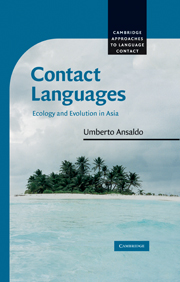Book contents
- Frontmatter
- Contents
- List of maps
- List of tables and figures
- Series editor's foreword
- Acknowledgements
- List of abbreviations
- 1 Introduction
- 2 The ecology of Monsoon Asia
- 3 Linguistic ecologies of Southeast Asia
- 4 Methodological issues in the study of contact languages
- 5 Contact language formation in evolutionary theory
- 6 Congruence and frequency in Sri Lanka Malay
- 7 Identity alignment in Malay and Asian-Portuguese Diaspora
- 8 Pidgin ecologies of the China coast
- 9 Implications, conclusions, and new horizons
- References
- Index
6 - Congruence and frequency in Sri Lanka Malay
Published online by Cambridge University Press: 18 January 2010
- Frontmatter
- Contents
- List of maps
- List of tables and figures
- Series editor's foreword
- Acknowledgements
- List of abbreviations
- 1 Introduction
- 2 The ecology of Monsoon Asia
- 3 Linguistic ecologies of Southeast Asia
- 4 Methodological issues in the study of contact languages
- 5 Contact language formation in evolutionary theory
- 6 Congruence and frequency in Sri Lanka Malay
- 7 Identity alignment in Malay and Asian-Portuguese Diaspora
- 8 Pidgin ecologies of the China coast
- 9 Implications, conclusions, and new horizons
- References
- Index
Summary
The wives, which in part are Amboinese, in part Singulayans, and Malabarians, say nothing against this, but when the men game away their little property, they must nourish him and his children as well as they can through the month and await his better fortune at gaming.
Christoph Schweitzer (ca. 1630)The story of the ‘Malays’ of Sri Lanka and their language is one of the most interesting and instructive examples of the formation of a new language as the result of language contact and identity alignment. Note that ‘Malay’ is a misnomer here: the term was used during British rule to classify people who came from Java and other parts of the Indonesian archipelago. The Dutch term ‘Javaans’ would be more appropriate for the ancestors of the Sri Lanka Malay (SLM) people, who, like other Malay Diasporas (e.g. the Cocos Malay), indeed refer to their own language as Java (see section 2.2.3). Unlike its better-known Caribbean Creole counterparts, SLM, like a few other varieties of the region (e.g. Baba Malay, Cocos Malay, see section 3.2 and chapter 7), is typologically in a unique position of providing us with an environment in which no (Standard Average) European acrolectal variety is involved in the dynamics of contact. Furthermore, with Sinhala and Tamil, its adstrates, the languages involved in the formation of SLM varieties come from three distinct language families: Austronesian, Indo-European, and Dravidian. As such SLM can shed light on issues of potential universality and language specificity in contactinduced language change (Ansaldo 2005, 2008, 2009 a).
- Type
- Chapter
- Information
- Contact LanguagesEcology and Evolution in Asia, pp. 122 - 147Publisher: Cambridge University PressPrint publication year: 2009

